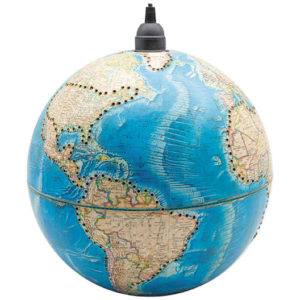 By Anne Gilbert
By Anne Gilbert Collector interest continues to grow and include anything having to do with outer space as well as our planet. This includes globes. We pretty much take them for granted, but they were once a treasured object. Surprisingly 18th century examples still come up for sale at hefty prices. One current example, made in Italy, is dealer priced at $38,500.
While these days anybody can afford a mass produced terrestrial globe, not so before 1930. In that year, Luther Repogle (1902-1981) began making globes by hand in his Chicago apartment and selling them. He used maps from England. The “Repogle Globe Company” later became “ScanGlobes” and is still making globes. Currently a status symbol globe is offered for an office desk made of silver. The countries are depicted in semi precious stones. The price is $585.00. Other have gold plated stands.
Historically, the earliest known were celestial. They were made for the purpose of tracking stars and planets in the night sky for early nautical navigation. The earliest still around was made by a cartographer, Martin Behaim in Nuremburg, Germany in 1492.
Globes were a popular collectible in England during the 18th century. Royalty and the wealthy often had both a terrestrial and celestial globe as status symbols. Small pocket globes were worn. These days retail prices could be in the thousands of dollars for the 2” globes.
 They were made in a variety of materials including glass, marble, wood and metal.
They were made in a variety of materials including glass, marble, wood and metal. Since globes were a trendy item, their stands were in the popular metal and wood furniture styles of the period.
Terrestrial globes didn’t just depict the world. Some show deserts and mountain ranges. Others showed countries and cities.
CLUES: Unfortunately reproductions of old globe maps abound. Most pre-mid 18th century globe maps were printed on laid paper and engraved. When held to the light they will show vertical and horizontal lines. They were hand painted with watercolors.
Reproductions, (restrikes) when examined with a magnifying glass will show a matrix of little dots. This is the same way you examine fake 19th century art prints.
A reputable or auction gallery should be willing to let you carefully examine and offer a money back guarantee if the globe isn’t as old as sold.
Globes come in many styles these days. They can be hanging wall lamps, mounted in vintage metal stands. When you examine a globe check for the countries and their names for the time frame when the globe was supposedly made.
PHOTO CAPTION: (1). Hanging globe light fixture PHOTO CREDIT: 1ST Dibs, New York, N.Y. PHOTO CAPTION: (2) Mid-18th century Italian globe. PHOTO CREDIT: 1ST Dibs. GB.















Follow Us